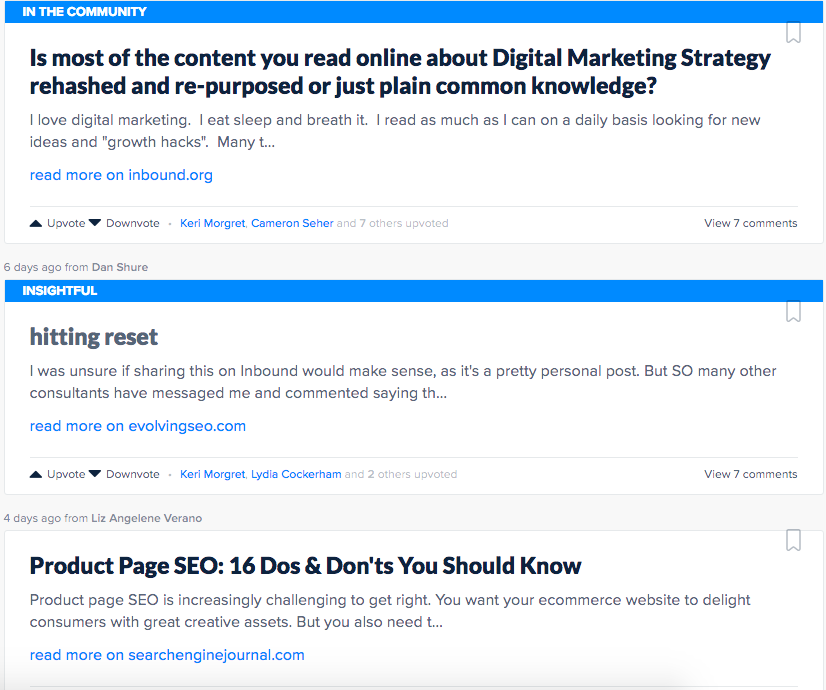Today, good enough isn’t. Not when millions of posts are published daily. Not when today’s average post is 1,054 words; requiring anywhere from three hours to an entire day to write.
Right. Like you’ve got that kinda time.
And yet, you still need results. You can’t afford to grok around in the dark, looking for the light switch as your posts continue to relish in obscurity.
No one can.
Chances are, your information is good. Facts are all there. But it’s not compelling enough to get people to sit up and take notice.
Here are five reasons why (along with how you can fix them ASAP).
Reason 1: There’s No Compelling ‘Hook’
The pretentious-sounding “lede” in journalism is what gets people to bite. It’s the compelling narrative, fact, stat, or story at the beginning that literally hooks people into reading the rest of the piece.
When done correctly, it builds anticipation to read what comes next. Here are three decade-old techniques to do just that.
1. Anecdotes
Jon Morrow makes me weep like a little baby. Or at least, his posts do. Like this one: On Dying, Mothers, and Fighting for Your Ideas.

The entire introduction is a story. It’s about the doctor telling Jon’s mom about his condition. The one that he’ll have to face his entire life and battle daily while bound to a wheelchair.
He masterfully builds suspense, adding in awkward pauses and compelling dialogue before finally bridging the gap between how this anecdote relates to the post topic.
As a result, the reader gets lost. It’s virtually impossible to read the few opening lines without finishing the entire piece.
Go on — I dare you.
2. Start on the Opposite Side of Where the Post Ends
Jon’s post also delivers on this second approach to writing hooks. It starts in a completely different place from where it will end.
There’s misdirection. You think you’re getting one thing, only to discover the opposite is true, which breaks the expectation you had in mind.
Sometimes that means making unlikely comparisons between two things. Like, say, Professional Chefs + Sales.
Other times that means picking a contrarian viewpoint. Like, United Airlines was Right to Forcibly Remove Disgruntled Passenger, leaving his face bloodied and battered. (Okay, I added that last bit.)
The point is that each misdirection catches you off guard and forces you to pay attention.
3. Lean on the Angle
The topic is what you’re writing about. The angle is what side you’re picking. How you’re conveying the topic at hand.
Example: This post’s topic is (generally) about blog post mistakes. But the angle is about how you can’t afford to be making these mistakes.
For various reasons. Based on stats. Etc. Etc. Re-read the introduction to see how it works.
Reason 2: You Ain’t Tellin’ Stories
Seth Godin called us all liars back in 2009. Since then, every marketer loves waxing poetic on the virtues of storytelling.
Only one problem…
No one’s telling any stories.
Why do 400-500 blog posts fail? It’s not because Google prefers long-form. It’s not like people really sit around and want to read thousands and thousands of words.
But short stuff often falls flat because it skips straight to the point. There’s no build up. No seduction. And as a result, it’s not appealing to people who lack your curse of knowledge.
Facts tell, stories sell.
Or how ‘bout those epic, 5,000-word skyscrapers. Impressive in size and scope, no doubt. I’m sure it took hours and hours to compile the research.
But the writing… well, not so much.
Guaranteed peeps are bouncing within the first 1,000 words (or “Saving it for later” — aka never — on Pocket or Evernote). Launching into dry, technical details without building the proper foundation drastically reduces the number of people interested in consuming what you’ve pored over.
The antidote is storytelling: opening with a compelling narrative that sets the context to get people to emotionally ‘butt in.’
“Made to Stick” is about making ideas, well, stick. Turns out one of the best ways is through storytelling. And specifically, by using one of these three tried-and-true plots:
- The Challenge Plot: Think Rocky Balboa (or the latest excellent installment, Creed). Someone — often a reluctant hero — has to rise up in the face of adversity and slay their real or imagined dragons.
- The Connection Plot: Think Romeo & Juliet. “Love conquers” and all that mushy stuff. Somehow, someway, two opposing forces are brought together from the unlikeliest places.
- The Creativity Plot: Think “Da Vinci Code”. A crazy (outlandish) puzzle, solved with ingenuity in unexpected ways.
Facts don’t resonate until you’ve built up the proper foundation with readers. Storytelling helps set the context.
Reason 3: Freestylin’ Instead of Following Proven Formulas
The short-lived hit TV show, “Revenge“ debuted in 2011. The first season’s story arc focused on a heroine who wanted to avenge her father’s wrongful murder. So she pretended to be like the people who were responsible in an effort to gain their trust and then completely destroy them all from the inside.
OK, so the plot lines were a little ridiculous. And the acting so-so.
But… that made for one interesting premise, right?
Of course, it did. This isn’t the first time you’ve heard it. In fact, it’s been around for centuries.
“The Count of Monte Cristo” was originally published in 1884. It featured someone who wanted to avenge their false imprisonment and take revenge against the three people responsible.
“Made to Stick” again recounts one experiment done by a group of Israeli researchers. They took the best advertisements who were either nominated or won awards and attempted to categorize them.
The researchers were only able to classify 2 percent of the ads that did not win a single award while they were able to classify 89 percent of the winners which followed one of six templates.
Turns out that people like formulas they’re familiar with. So if it ain’t broke, don’t fix it!
Storytelling in a blog post should often follow the PAS formula. This age-old copywriting framework has been used for decades and decades to lure readers in.
Here’s how it works:
- Problem: Your blog posts aren’t getting the readers they deserve.
- Agitate: But it’s only getting tougher; requiring more time and effort than ever before.
- Solution: Unless… you fix these five little issues.
Reason 4: You Lack a Distinct Voice & Tone
MailChimp is wholly distinct. No one else looks like them online. No one else sounds like them, either.
Inside the app, Freddie pops up with all sorts of quirky tidbits. Like, for example, the time he referenced alcoholic Vervet monkeys.

Apparently, that’s not a coincidence but a well-planned strategy. Each new writing hire has to go through their style guide, voice, and tone.

That way everyone knows exactly how Freddie should walk and talk and sound.
Then there’s Stone Brewing company. Their tagline? “You’re not worthy.”
The label on their Arrogant Bastard ale literally says, “This is an aggressive beer. You probably won’t like it. It is quite doubtful that you have the taste or sophistication to be able to appreciate an ale of this quality and depth.”
Um… OK?!
Putting down your customers doesn’t seem like a smart move. And yet, it’s risen to become the 10th largest craft brewer in the U.S.
Zagat says their headquarters in San Diego county is, “The place to be if you’re a beer geek.” And they’ve been rated as ‘World Class’ by both RateBeer and BeerAdvocate (the two snobbiest sites for beer snobs).

They have a distinct style. It’s definitely not right for everyone. But that’s also why it works for those who enjoy it.
In a world full of nameless, borderline tasteless beer, they stand out head and shoulders above everyone else.
Blog posts are no different. Millions published each and every day.
That brilliant topic you’re to write about? It’s undoubtedly already been written about. Probably hundreds of thousands of times.
So how are you going to make it stand out?
Reason 5: You’re Not Interrupting Well-worn Patterns
An ‘open loop’ will introduce one story or point. It will build anticipation. But before relieving that tension, it will open up another parallel story.
Think back to your favorite TV show or novel. Something unexpected happens. You’re dying to find out the fallout. But then they cut to a commercial break, and open with a completely different story. That forces you to keep watching until the end to see how it all comes together.
That same ‘pattern interrupting’ technique works online, too.
Something unexpected, shocking, or surprising forces our lizard brains to sit up and take notice. When an ‘information gap’ is created, we’re biologically driven to fill it. Curiosity, can indeed, kill the cat.
That’s also why polarizing headlines are considered the most powerful, according to a study of 69,907. Or why asking a question (without providing the answer) can raise email responses to 60 percent.
Here’s a perfect one that caught me recently from Drift:

Not using lead forms is like blasphemy in today’s digital marketing realm. It makes absolutely no sense. Sounds crazy! So of course, I had to read it.
Here’s another. Imagine you’re scrolling down Inbound.org, reading all the various blog post titles. They’re all written by savvy marketers using the same ‘playbooks.’ So they all look and sound the same (for the most part).
Until this next one catches your eye:

Sure. The first and third ones look interesting. But it’s the middle one that catches your eye.
It’s short. All lowercase. And vague or mysterious sounding compared with all of the other alternatives you just scrolled past.
So, of course, you can’t help but click.
Conclusion
Just getting your blog posts read today is an achievement in and of itself. It’s an uphill climb. Each and every day. Just to get a few measly eyeballs on your latest masterpiece.
The good news is that a few simple tweaks can make all the difference.
Start with a more compelling hook. Add a few more stories. Stick to a proven formula. Use a distinct voice and tone. And don’t be afraid to break a few patterns.
It takes a little bit of extra work. But the results will be worth it.
Image Credits
Featured Image: Pixabay
Screenshots by Brad Smith. May 2017.




